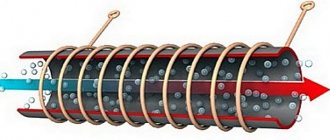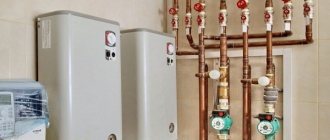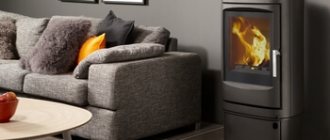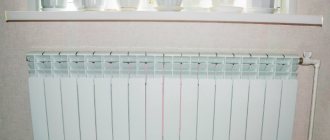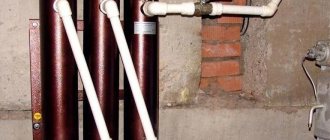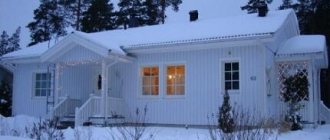Due to the constant rise in prices of common energy sources (gas, oil, electricity) and the difficulty of connecting them, private homeowners prefer to find another solution to the problem of heating and hot water in their home. Returning to wood heating is one reasonable solution. Moreover, modern wood-burning boilers are quite relevant and effective as the basis of a heating system, allow different levels of automation and are economically beneficial, being the second most common after gas boilers.
What are solid fuel wood boilers?
The market for wood-burning boilers offers a huge number of different external models, but what they have in common with the brick wood-burning stove of the past is the presence of devices with a similar purpose: a firebox (fuel combustion chamber), a ash pit, a brick mass (heat exchanger) and a chimney. These components are present in any boiler, but modern technology and engineering have brought the efficiency of the components to a level unattainable in a furnace.
The application of the principles of wood combustion control with an efficiency increase of up to 92% and a loading period of several days make such boilers quite capable of competing with both gas and liquid fuel ones. Firewood in modern high-tech devices burns with almost no ash or emissions into the atmosphere.
Design and principle of operation
Construction of a modern budget wood-burning boiler using the example of Teplodar Kupper Pro.
At its core, the operating principle of a wood-burning boiler remains unchanged:
- Loading firewood into the firebox (combustion chamber).
- Ignition of fuel.
- Installation of oxygen supply to burning fuel.
- Heating the coolant in the heat exchanger.
- Discharge of combustion products through the chimney into the atmosphere.
- Discharge of heated coolant into the heating system.
- Removing ash from a furnace or boiler.
The goal of extracting all the energy it can provide from burning wood encourages boiler designers and manufacturers to improve the design of each component to accomplish these points with maximum efficiency.
The method of supplying oxygen to the combustion zone and removing combustion products divides boilers into:
- non-volatile, autonomous . The ash door is controlled mechanically, and combustion products are released into the atmosphere due to the pressure difference created by the chimney pipe and the firebox;
- volatile . Oxygen is supplied by a pressurization fan, and smoke with the remains of unburned fuel is pulled out of the firebox by a fan-exhaust fan, so for the boiler to operate, it must be connected to the electrical network through a standard socket.
The method of controlling the combustion and loading process divides wood boilers into several types:
- direct (direct) combustion - a direct analogue of a brick stove, in which the fuel, burning, heats water in a steel or cast iron container for heating the house;
- long burning - sometimes these are simply models with a larger firebox and a more complex heat exchanger, but the most successful are mine boilers, in which long burning is ensured by the “top-down” combustion principle - slow smoldering of only the top layer of fuel;
- gas generator (pyrolysis) boiler unit - it separates the smoldering phases of the fuel (the release of pyrolysis gases and their afterburning in another combustion chamber with the release of a large amount of thermal energy), this makes it possible to achieve greater efficiency and combustion duration of one load, less ash.
Boilers with a burning duration of one load of fuel up to 7 days
Long burning boilers
One not very pleasant necessity when operating a wood-burning heating unit is the regular loading of firewood into the firebox. In most boilers of older designs, it is necessary to load a portion of fuel every 3-4 hours. To overcome this problem, long-term combustion models have been developed in which fuel is added every 1-3 days. In addition to the fact that the furnace capacity of such boilers has increased overall dimensions, they use the principle of top combustion.
After the system reaches the nominal mode (the coolant reaches the set temperature), the control switches the fuel combustion to smoldering mode, reducing the supply of oxygen to the top layer of the fill.
Visual process of long-term combustion.
The fuel smolders layer by layer, falling down a stack of properly stacked firewood, maintaining the set temperature in the rooms. In experienced hands, such a long-burning, wood-burning solid fuel boiler can operate for more than three days, but on average, raw materials need to be loaded once every two days. The duration of work on one bookmark depends on the quality of the firewood, adjustments of the combustion mode and the correct placement of firewood in the firebox.
Pyrolysis boilers
Operating principle of pyrolysis boilers.
Modern gas generator boilers are used for greater efficiency and savings (due to afterburning of pyrolysis gases). After reaching the desired operating mode of the boiler, at a certain temperature, smoldering firewood begins to intensively emit wood (pyrolysis) gas. This high-energy product is discharged into the second combustion chamber, is saturated with oxygen and burns, releasing a large amount of heat. The burning air-pyrolysis mixture is driven by a smoke exhauster through a complex heat exchanger, transferring maximum energy to the coolant.
High efficiency of complete fuel combustion (efficiency up to 95%) in such boilers is achieved by the presence of different levels of automatic systems, fans, and sensors. Under computer control, such heating systems are rarely energy independent. In addition, such boilers are very critical to fuel moisture.
Home installation
The boiler is placed in the room:
- up to 40 kW – separate inside the house;
- over 40 kW – attached outside.
An average-capacity household unit is placed on the floor . Industrial power from 50 kW - on its own foundation, resting on the ground and not connected to the building structures.
Minimum distance to walls at the sides and rear: 70 cm.
Front at:
- loading from above: 1.2 m;
- front: 1.2 m + combustion door width.
When installing, the level controls the horizontalness of the firebox. Wooden floors and walls are protected with tin lined with basalt cardboard or covered with vermiculite plaster.
A safety valve, a pressure gauge and an air vent (safety group) are screwed successively to the supply pipe, then a pipe. Threaded connections are sealed with tow.
The supply and return pipelines are connected by a jumper, and an automated mixing unit is installed on it. This is done to prevent water with a temperature below +50ºС from entering the heat exchanger, which is accompanied by the formation of acidic condensate, which is harmful to the metal.
The heating system is assembled using a two-pipe scheme. The alternative with a series arrangement of radiators is impractical: the outermost battery receives little heat.
The connection point with the chimney pipe is sealed with heat-resistant sealant.
Models with heating elements are connected to the electrical panel with a separate wire. A circuit breaker and an RCD are installed on the line, and the heater is grounded.
Reviews of domestic wood heating boilers: advantages and disadvantages
| Advantages | Flaws |
| The cheapness and availability of wood, omnivorousness to other types of solid fuels make obtaining heat, hot water and cooking inexpensive | Capital investments in good equipment are high and increase significantly with the increasing level of automation (as well as the manufacturer’s brand) |
| You do not need permission to install equipment, as when connecting power to electrical networks and gas mains. No need to pay a subscription fee for service | Organizing a seasonal fuel warehouse will require space, investment and effort |
| Ease of use – for most boilers, control and maintenance are clear and not burdensome | Installing a boiler in a residential building is not advisable, there will always be minimal odor, a bulky boiler unit and two or three portions of fuel must be taken out into the annex |
| Fire danger and carbon monoxide poisoning are excluded in modern boilers if the instructions are followed. | Despite the boiler manufacturer’s promises to free the owner from many responsibilities due to automation and computer control, regular monitoring is necessary |
| Prices for the most budget wood-burning models start from 13-14 thousand rubles | |
| Availability of both single-circuit and double-circuit models |
How are they different from other equipment?
In terms of the method of obtaining energy for heating premises, outdoor boilers are similar to traditional ones. Their indisputable advantage is that there is no need to specially equip the room for installing the unit. This factor eliminates the risk of fire or other threats to people living in the house.
The absence of a boiler room will eliminate a number of measures related to ensuring safety, and in the case of installing a unit on natural gas, it will eliminate the design and expensive installation of pipes.
How to choose a wood boiler
Before you start choosing a wood-burning boiler model, you need to decide on its future purpose: heating a country house, a summer cottage. Then decide on a budget and, in order not to be disappointed with the result, study the parameters of the available equipment. The need for a homeowner to be confident in their requests before communicating with the seller is a prerequisite for getting something that will not disappoint after purchase and will last for many years.
Direct, long burning or pyrolysis
Traditional direct combustion boilers are an analogue of a furnace; they are extremely easy to operate, do not require connection to the electrical network, are unpretentious in terms of fuel quality and are cheap. However, they allow power and temperature adjustment only within small limits and have low efficiency. If the future owner of the unit is ready, as a boiler room operator, to monitor the temperature of the water in the system, load logs every 3 hours, close the vent and damper in time so as not to get burned, not overheat the water and not let the fire go out in winter - this is a good, profitable and very budget-friendly option. choice. Moreover, even inexpensive modern options are much more practical to maintain than old-style models.
When choosing a wood-burning boiler with long burning for a summer house or a house with year-round living, you can get a completely autonomous system with mechanical control or a volatile one with a low level of automation. The efficiency of such units is significantly higher than that of the previous ones; a well-regulated smoldering process can work effectively for up to 10-12 hours on one load; in some models of well-known brands (STROPUVA, LIEPSNELE), additional loading is possible once every 2 days. The cost of such equipment occupies the average niche of the market.
Currently, the most effective are gas-generating boilers with various levels of automation. They are mostly energy dependent and very demanding on the quality of firewood. But they have high performance characteristics: efficiency up to 95%, long periods between loads (up to 5 days), smooth power adjustments, computer control with control via a mobile phone, etc. Naturally, this level of comfort is expensive and very expensive.
Heat exchanger material
To burn wood, it is better to use a cast iron boiler; it cools down longer and lasts for centuries. But the choice here is:
- steel heat exchanger - lighter in weight, easier to transport and install, it is repairable (can be welded), cheaper, efficiency is the same as cast iron, but durability depends on thickness and operating conditions, since steel is susceptible to corrosion (service life 12-18 years) ;
- cast iron heat exchanger - it is heavier in every sense, fragile, damaged sections can only be replaced, but if treated with care and avoiding a large temperature difference between the supply and return, it will last a long time (at least 30 years).
Important differences between cast iron solid fuel boilers for heating a private home and cottage
Single-circuit or double-circuit
The first option, single-circuit (usually more powerful), is used only for heating. Some models already from the factory allow operation with an indirect heating boiler to produce hot water, but in general, such a scheme can be organized in conjunction with any wood-burning boiler.
Double-circuit ones are structurally designed and created for heating and hot water supply. When choosing, it is necessary to evaluate the heated area, as well as the temperature and amount of hot water produced by the water circuit per hour during normal operation.
Despite the fact that a double-circuit boiler is the cheapest way to organize hot water supply in a house, in the case of a solid fuel boiler it is better to take a single-circuit model and connect an indirect heating boiler, this is much more practical.
What are modern double-circuit solid fuel boilers?
Efficiency
The higher the efficiency of the boiler, the lower the fuel consumption and the more complete accumulation of thermal energy it can provide. However, the nominal value of this parameter requires scrupulous compliance with the manufacturer’s instructions. This primarily concerns the fuel: type of wood, humidity, correct installation. Then: careful adjustment of combustion control at all stages and timely routine maintenance work. Under all conditions set by a reliable manufacturer, the declared efficiency is quite achievable.
Having decided on the previous, more important, parameters, it is worth starting from efficiency values of 80-85% (for direct combustion boilers). Lower figures today indicate significant technical imperfection.
Minimum required power
For solid fuel boilers, rough calculations of the minimum required power are usually sufficient. Therefore, in practice, the rule is that to heat a room with normal ceilings up to 3 m high, standard insulation requires about 1 kW of power per 10 m2 of area. We also recommend setting aside + 20% reserve for inaccuracies and possible expansion of consumption. If you plan to use hot water supply, you need to factor in another +20%.
For example: for the above-described house with an area of 200 m2, the minimum boiler power is (200/10) * 1.2 = 24 kW for heating, and if there is also DHW - 24 * 1.2 = 28.8 kW.
Difficulty of maintenance
The boiler is designed to distribute heat using a water heating system consisting of pipes and radiators.
The use of a liquid working medium entails the following difficulties:
- danger of leaks, freezing and boiling;
- reduction in the service life of the unit due to corrosion and scale fouling of the boiler tank;
- purchase of expensive components: valves, hydraulic accumulator, valves, air vent, pump, pressure gauge.
The stove heating method, based on the use of a convector, is cheaper and easier to implement. Hot air is distributed through a system of plywood channels with dampers, available for self-production.
Chimneys to which solid fuel boilers are connected must be cleaned of soot annually, otherwise it may ignite. This reduces the service life of the pipe and creates a risk of fire. It is also recommended to clean the inside of the heater from soot, since it plays the role of a heat insulator.
Firewood must be dried to a moisture content of 20%. Raw fuel produces less heat (increases consumption) and covers surfaces abundantly with soot. For natural drying, freshly sawn wood should be stored under a canopy for 2 years.
The best known manufacturers and models: characteristics and prices
The presence of German-made units from well-known brands is noticeable on the domestic market. Typically, it is characterized by a high level of automation, careful execution and increased requirements for compliance with environmental regulations. Equipment and additional options provide owners with any level of comfort, but they are very scrupulous about the quality of local fuel and, without serious preparation, may not provide the promised power and efficiency.
Czech and Slovak production supplies us with fairly high-quality equipment for heating private houses. They are quite comparable in level of automation, reliability and safety with German ones, but at lower prices. Russian production is also gradually becoming noticeable in this market. First of all, this is a large number of simple, but quite modern low-budget boilers.
Teplodar Cooper Praktik 14
One of the best and most common wood-burning boilers for heating a private home or cottage. A simple, single-circuit, mechanically controlled classic direct combustion boiler with a power of 14 kW. Despite the fact that it is positioned as non-volatile, it has a pre-installed block of heating elements with a power of 6 kW, which can help maintain the temperature in the system by connecting it to an outlet. According to reviews from the owners, the power of the heating elements is enough to keep the house warm until the morning after the last filling burns out in the evening (with an area of up to 150 m2).
The efficiency is not so great - 80%, but for the most budget price segment it is more than sufficient. When fully loaded, the burning time of one portion of firewood is 8 hours. There are also disadvantages inherent in most budget models: a steel heat exchanger, a small combustion chamber, limiting the length of the logs.
Protherm “Beaver” 20 DLO
A Slovak cast iron boiler is one of the best options if the budget is not limited to 20-30 thousand rubles. Among single-circuit direct combustion boilers with mechanical control, this one stands out for its high efficiency of 91% and low heat losses (thanks to the complex design of the heat exchanger and good alloy). Almost all owners note the excellent build quality, the acceptable size of the firebox window, through which firewood up to 30-32 cm can easily fit, and the practical design of the boiler. The ash drawer is large, very easy to remove, and quite easy to clean.
Over the course of installation practice and more than 7 years of operation, the model has proven itself to be absolutely problem-free, which is not surprising, since there is nothing to break in such a simple, cast-iron design. The only drawbacks are the heavy weight, typical of cast iron boilers, as well as the firebox is not deep enough; when adding wood, ash can fly out of it.
Viadrus Hercules U22 D4
Another Czech-made boiler. Single-circuit, direct combustion, with a cast iron heat exchanger, but its efficiency is lower - 80%. For this reason, the fuel requirements are much simpler: you can use not the driest firewood with a humidity of more than 25% and a length of up to 34-35 cm. This is an excellent alternative to Protherm “Beaver” when you plan to use firewood of any quality. The assembly is still of the same high quality, the design is practical, and there are no serious reliability problems known.
The disadvantages are the heavy weight of the unit - 247 kg (with a power of 24 kW), and also not the most affordable price.
Kentatsu ELEGANT-03 17
Single-circuit direct combustion mechanical boiler, Turkish production and assembly, but designed and developed in Japan. This is one of the cheapest cast iron models on the market. At the same time, it has a very good design and efficiency: efficiency – 80%; compact dimensions; the presence of a layer of thermal insulation that reduces heat loss through the body; protected from overheating by water-cooled grates.
Due to the low price, there are more disadvantages: mediocre build quality, small firebox and combustion time for one load of up to 4 hours. It is also important to understand that the service structure in Russia is not so developed and is completely absent in a large number of regions.
Cost: 32,000-36,900 rubles.
Buderus Logano S171-22W
High-tech German pyrolysis boiler with a lower gas afterburning chamber. It is distinguished by high efficiency up to 89%, and a large number of modern automation systems: adjustable speed of the blower fan and smoke exhauster; control of heating system circulation pumps; accounting of external temperature sensors; control from mobile phone and PC.
Separately, it is worth noting the size of the firebox and the practicality of the design, since for burning you can easily use logs up to 58 cm long. The burning duration is on average 3-4 hours, the wood consumption is on average 6.2 kg/hour. The heat exchanger here is not cast iron, but made of thick 5 mm furnace steel. Of course, you need to be connected to an electrical outlet to operate. Apart from the high price, it is difficult to find any shortcomings.
Cost: 179,000-198,000 rubles.
STROPUVA S20
The most famous Lithuanian model of long-term combustion of the shaft type (with top combustion). The main type of fuel is wood, but the boiler can also burn other types of fuel such as coal, peat, pellets. Efficiency is 85%, the 20 kW model has a firebox volume of 262 liters, and can operate for up to 40 hours on one load of wood (and up to 7 days with coal). In this case, you can use logs up to 45 cm long. The boiler is completely energy-independent, the heat exchanger is cast iron, in a steel casing.
The only disadvantages are the relatively high fuel requirements, abundant formation of tar on the walls and the large weight of the boiler - 231 kg.
Cost : 89,000-110,000 rubles.
Criterias of choice
When purchasing, you need to pay attention to the following factors:
- Availability of fuel on which the boiler operates.
- You should not purchase a unit with maximum power or more than necessary. A device operating in nominal mode uses fuel much more efficiently.
- The parameters of the boiler are closely related to the dimensions of the room where it will be installed. Insufficient air volume in the boiler room or weak air pressure has a significant impact on the performance of devices with forced injection.
- The efficiency of the device varies when operating on different types of fuel. When choosing a boiler, you need to pay attention to the efficiency of its operation on the fuel that will be used most often.
- Units with a cast iron heat exchanger are more reliable than steel ones.
- The weight and dimensions of the equipment affect the requirements for the boiler room. It is necessary to discuss in advance with specialists how the unit will be delivered to the installation site, whether the doorway is wide enough to accommodate it, and whether the base on which the device will stand is strong enough.
- Door height for loading fuel and cleaning the ash pan. It should be convenient to maintain the installation and fill it with firewood.
- Boiler cost. The price is determined based on the technical characteristics, and also depends on the reputation of the company and the time during which the equipment of this brand has been produced.
Properly organized heat supply significantly affects indoor comfort. Rational use of resources for high-quality heating of housing, industrial or commercial facilities largely depends on the boiler unit. For this reason, you need to approach the choice of heating installation responsibly.
Prices: summary table
| Model | power, kWt | Efficiency, % | price, rub. |
| Teplodar Cooper Praktik 14 | 14 | 80 | 20 000-27 000 |
| Protherm “Beaver” 20 DLO | 19 | 91 | 79 000-83 000 |
| Viadrus Hercules U22 D4 | 24 | 80 | 59 000-90 000 |
| Kentatsu ELEGANT-03 17 | 17 | 85 | 32 000-36 900 |
| Buderus Logano S171-22W | 22 | 89 | 179 000-198 000 |
| STROPUVA S20 | 20 | 85 | 89 000-110 000 |
The summary table reflects the approach of our manufacturers to the production of wood-burning boilers for heating. The price and declared characteristics in the first position may well suit a villager and not tempt him to experiment with homemade boilers. In our open spaces, such a low-budget boiler is preferable at long distances from service centers.
Two-pipe scheme: efficient heating for the home
A two-pipe heating circuit is installed as follows:
1. A “hot” coolant circuit is connected to the upper pipe of the heating boiler, which rises to the ceiling and stretches at this level along the walls of the entire house. In this case, the “lift” - a vertical section of the pipeline that connects the upper section of the wiring with the boiler, ends with a tee, to the end of which the entire circuit is mounted. The upper branch of the tee is used to extend the heating circuit to the next floor or to install an expansion tank.
2. A waste coolant circuit (return) is connected to the lower pipe of the heating boiler, which stretches along the perimeter of the walls of the house at floor level. All branches with waste coolant, which are laid at the level of interfloor ceilings, can be embedded into the return line mounted at the level of the basement floor. For this purpose, special vertical “descents” are organized. The circular pump and drain pipe are installed at the lower pipe of the heating boiler, on the basement return.
3. Heating radiators are installed under the windows on each floor of the house. In this case, a nipple for bleeding air is cut into the upper left radiator pipe, and a valve is cut into the upper right pipe, which regulates the flow capacity. Accordingly, an outlet is connected to the lower left nozzle (a special corner bent down), and the lower right nozzle is closed with a plug.
4. Further assembly of the system proceeds as follows. An insert is arranged in the upper “hot” pipe, from which a vertical section of pipe extends, which connects the circuit with the control valve of the heating radiator. The same insert is installed in the “cold” pipe, which connects the radiator outlet with the return.
Two-pipe heating circuit
The result is a reliable, functional system that effectively heats even houses several stories high. The double-circuit wiring diagram allows you to regulate the temperature of each radiator, which is especially appreciated in individual residential buildings.
How to burn properly and what kind of wood is best
The operating instructions for a wood-burning boiler determine the basic requirements for the fuel at which it produces the declared parameters. Typically, the passport indicates the length of the logs and, for some models, their diameter, depending on the size of the firebox. The optimal humidity of raw materials is also indicated in the documents and does not exceed 20%. Of the tree species, it is better to use denser wood species: ash, birch, alder. Their calorific value is on average 25% higher than that of coniferous species: spruce, pine.
Before putting the boiler into operation, it is advisable to warm up the firebox and chimney with a small, no more than 50% load of firewood. Paper, splinters, wood chips and light logs are placed on the grates. Then the whole thing is set on fire and filled with firewood up to half of the firebox so that air circulation is possible between the logs. You need to let this batch burn out with the ash pan closed and the chimney damper open. Then the ash pit and firebox are cleaned and the main batch of firewood is stacked denser than before, and the boiler is put into operation. To obtain the desired parameters, you should initially strictly follow the recommendations of the equipment manufacturer; with experience, you will understand how best to achieve the desired result.
Wood boilersBoilersSolid fuel boilers
Principle of operation
The coolant that fills the water jacket is heated by the energy of the burned fuel. Circulation pumps supply hot working fluid through an insulated underground pipeline into the house, where it is distributed to radiators. The cooled water returns to the boiler mediastinum for reheating.
As the fuel burns out, additional loading is carried out and the ash pan is cleaned.
Flaws
Of course, solid fuel boilers are not without some disadvantages. If you buy cheaper equipment, you will need to add firewood to it every 2-4 hours. Therefore, you cannot leave him unattended. In addition, you need a place to store fuel, such as woodpiles or special sheds.
Heating wood boilers for the home are sensitive to the quality of the fuel - the firewood must be absolutely dry, otherwise the efficiency of the device will decrease by almost half. Of course, high-tech equipment equipped with automatic fuel supply and temperature control can cope with such a problem. However, it is quite expensive.
Let's take a closer look at the main types of wood-burning boilers based on the price factor.
What is wood moisture content and what does it affect?
Wood moisture content is an indicator that reflects the moisture content in the material. If we look at a specific example, then 100 kg of firewood, where the humidity is 25, contains 75 kg of wood and 25 liters of water. This indicator directly affects the heat generated: the less moisture inside the tree, the more heat it releases during combustion. Thus, several categories of wood can be distinguished by composition:
- Driftwood that contains more than 80% moisture. Usually it stays in water for a long time or is fused - due to this it gains such an amount of moisture.
- Freshly cut wood (moisture content from 45% to 80%) - it usually still contains natural moisture, since the cut occurred recently.
- The air-dry type contains from 20% to 45% - it is pre-dried in an open area.
- Room-dry type of wood (from 7 to 20%) - this type of material is kept in a dry and ventilated place for a long time, so almost all the moisture evaporates (sometimes a drying chamber can be used for this).
- Absolutely dry variety (0%) - in this case the material is thermally treated.
If you need to dry wood at home, then even with the most ideal indicators you will be able to achieve no more than 15-20% moisture. It is possible, of course, to improve this indicator, but the costs will not be recouped. That is why it is not recommended to spend money on special conditions for storing wood.
Features of coal combustion
Let's look at how to properly heat a solid fuel boiler with coal. For kindling, wood chips approximately 5 cm thick are used, which must be laid out on paper. You need to put 3-4 logs with a diameter of 10-15 cm on top of the wood chips. After this, you need to set fire to the paper and close the firebox door, as well as cover the ash pan. In this case, the draft must be sufficient to ignite the firewood. If the boiler is equipped with a slide valve, then it is only slightly opened when lighting. If there is a thermostat, then it should be set to a temperature of 70-80 °C.
Coal can be added after 15-20 minutes of intense burning of the logs, when the chimney and the boiler itself are already sufficiently warm. In this case, you need to reduce the temperature set on the thermostat and fully open the gate valve. Before throwing coal, be sure to close the ash pit. The first layer of coal is laid with a thickness of 5-6 cm. After it burns out, a second layer with a thickness of about 15-20 cm is laid. Further layings also have this thickness.
It is also important what kind of coal to heat a solid fuel boiler. When using fine-grained fuel (up to 5 cm), it should be moistened by adding about a liter of water to a bucket of coal. The optimal fuel is large anthracite of a fraction of 6 cm. It does not require wetting. Water is added only if it is necessary to prevent overheating of the boiler.
Fireplaces for home
Fireplaces have the longest history among home heating devices. At first they were an open fireplace in the middle of the room. Over time, various structures for removing smoke - smoke collectors - began to be built above the fireplaces. Nowadays, a fireplace is no longer needed so much for heating as for aesthetics and comfort.
There are the following types of fireplaces: electric, wood-burning, gas, bio-fireplaces, fireplace-stoves and decorative fireplaces.
According to the name, the principle of operation of electric fireplaces is the use of electricity. This eliminates the problem of constructing a chimney. Wood-burning fireplaces “work” on wood and are designed to create real comfort in the home. Date: September 25, 2021
